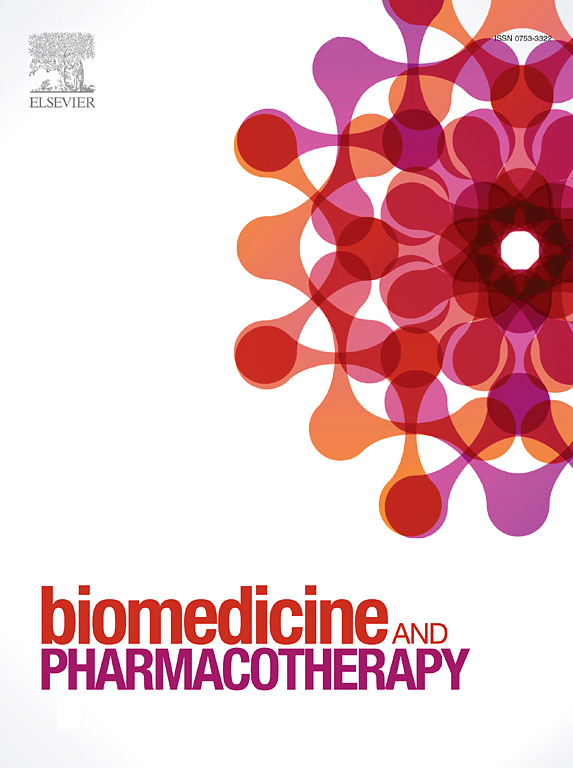Modulation of chemotherapy-induced peripheral neuropathy by JZL195 through glia and the endocannabinoid system
IF 6.9
2区 医学
Q1 MEDICINE, RESEARCH & EXPERIMENTAL
引用次数: 0
Abstract
Chemotherapy-induced peripheral neuropathy (CIPN) used to treat cancer, is a significant side effect with a complex pathophysiology, and its mechanisms remain unclear. Recent research highlights neuroinflammation, which is modulated by the endocannabinoid system (ECS) and associated with glial activation, and the role of toll-like receptor 4 (TLR4) in CIPN. This study aimed to investigate the effects of JZL195, an inhibitor of fatty acid amide hydrolase (FAAH) and monoacylglycerol lipase (MAGL), and explore the connection between cannabinoid receptors and TLR4 in glial cells. A CIPN animal model was developed using cisplatin-injected male C57BL/6 mice. Mechanical and cold allodynia were assessed through von Frey and acetone tests. Western blot analysis was used to examine the expression of catabolic enzymes, cannabinoid receptors, glial cells, and neuroinflammatory factors in the dorsal root ganglia (DRGs) and spinal cord. Immunohistochemistry was used to investigate the colocalization of cannabinoid receptors and TLR4 in glial cells. JZL195 alleviated pain by inhibiting FAAH/MAGL, modulating the ECS and neuroinflammatory factors, and suppressing glial cell activity. Additionally, cannabinoid receptors and TLR4 colocalized with astrocytes and microglia in the spinal cord. This study highlights the therapeutic potential of JZL195 in modulating the ECS and suggests a correlation between cannabinoid receptors and TLR4 in spinal glial cells, providing insight into alleviating pain and neuroinflammation in CIPN.
JZL195通过神经胶质细胞和内源性大麻素系统调节化疗引起的周围神经病变
用于治疗癌症的化疗诱发周围神经病变(CIPN)是一种严重的副作用,其病理生理学十分复杂,其发病机制仍不清楚。最近的研究强调了神经炎症(由内源性大麻素系统(ECS)调节并与神经胶质激活相关)以及收费样受体4(TLR4)在CIPN中的作用。本研究旨在探讨脂肪酸酰胺水解酶(FAAH)和单酰甘油脂肪酶(MAGL)抑制剂JZL195的作用,并探索胶质细胞中大麻素受体和TLR4之间的联系。利用顺铂注射雄性 C57BL/6 小鼠建立了 CIPN 动物模型。通过 von Frey 和丙酮试验评估了机械和冷异感。采用 Western 印迹分析法检测背根神经节(DRGs)和脊髓中分解酶、大麻素受体、神经胶质细胞和神经炎症因子的表达。免疫组化法用于研究神经胶质细胞中大麻素受体和 TLR4 的共定位。JZL195 通过抑制 FAAH/MAGL、调节 ECS 和神经炎症因子以及抑制神经胶质细胞活性来缓解疼痛。此外,大麻素受体和 TLR4 与脊髓中的星形胶质细胞和小胶质细胞共定位。这项研究强调了JZL195在调节ECS方面的治疗潜力,并表明脊髓胶质细胞中的大麻素受体和TLR4之间存在相关性,为缓解CIPN的疼痛和神经炎症提供了启示。
本文章由计算机程序翻译,如有差异,请以英文原文为准。
求助全文
约1分钟内获得全文
求助全文
来源期刊
CiteScore
11.90
自引率
2.70%
发文量
1621
审稿时长
48 days
期刊介绍:
Biomedicine & Pharmacotherapy stands as a multidisciplinary journal, presenting a spectrum of original research reports, reviews, and communications in the realms of clinical and basic medicine, as well as pharmacology. The journal spans various fields, including Cancer, Nutriceutics, Neurodegenerative, Cardiac, and Infectious Diseases.

 求助内容:
求助内容: 应助结果提醒方式:
应助结果提醒方式:


